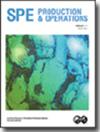利用流入示踪技术监测水平注采井聚合物驱性能
IF 1.3
4区 工程技术
Q2 ENGINEERING, PETROLEUM
引用次数: 1
摘要
在聚合物增强注水中,水平井经常用于增加注入能力和成本效益高的开采动员油。通常,只有生产井井口的流体和聚合物生产数据可用。我们使用流入示踪剂技术来确定聚合物注入引起的碳氢化合物流入的变化,并确定从水平注入器的各个区域到水平生产器的连接。在聚合物水平注采井中引入了流入示踪剂技术。在生产井中,示踪剂在与水和石油接触时会释放出来。在水平生产井中使用了石油和水示踪剂系统。观察到的示踪剂浓度的变化被用来量化由于聚合物注入而引起的水平生产商各个部分的流入变化。在水平注入井中应用的流入示踪剂技术证明了注入井的不同部分与周围的两个垂直和水平生产井之间的连通性,并为井间水示踪剂应用打开了该技术的使用大门。流入示踪剂技术使人们能够阐明水平井各个部分的流入及其变化,甚至量化各种流体(油和水)流入的变化。这些信息显示了哪些部分起作用,以及由于聚合物溶液注入,不同区域的石油流入量发生了实质性变化。根据示踪剂结果,可以将总增量油分配到各个水平井段。即使是在聚合物注入前几乎只产水的区域,其石油流入量也显著增加。安装在注入井中的流入示踪剂技术使我们能够分析注入器与生产商的连通性,不仅在全局上,而且在水平井的空间上。这些数据用于储层表征、数值模型调节和储层管理。常规的井间示踪剂技术使人们能够确定水平井聚合物油田开发的连通性和连通体积。然而,它既没有揭示有关井段流入的信息,也没有揭示水平井各井段的连通性。流入示踪剂技术填补了这一空白;它允许人们量化流体流入的变化。此外,新开发的安装注入井示踪剂技术提供了有关水平井段连通性的空间信息。本文章由计算机程序翻译,如有差异,请以英文原文为准。
Monitoring Polymer Flooding Performance Using Inflow Tracer Technology in Horizontal Injection and Production Wells
Horizontal wells are frequently used to increase injectivity and for cost-efficient production of mobilized oil in polymer-augmented waterfloods. Usually, only fluid and polymer production data at the wellhead of the production well are available. We used inflow tracer technology to determine changes in hydrocarbon influx owing to polymer injection and to determine the connection from various zones of the horizontal injector to the horizontal producer.
Inflow tracer technology was introduced in horizontal polymer injection and production wells. In the production wells, tracers are released when they are contacted by water and oil. Oil and water tracer systems were used in the horizontal production wells. The changes in the observed tracer concentration were used to quantify changes in influx from various sections of the horizontal producers owing to polymer injection. The inflow tracer technology applied in the horizontal injection wells demonstrates connectivity between different sections of the injection wells and two surrounding vertical and horizontal production wells and opens the usage of this technology for interwell water tracer applications.
Inflow tracer technology enables one to elucidate the inflow from various sections of the horizontal wells and the changes thereof, even quantifying changes in influx of various fluids (oil and water). The information shows which sections are contributing and the substantial changes in the influx of oil from the various zones due to polymer solution injection. The overall incremental oil could be allocated to the various horizontal well sections based on the tracer results. Even zones that almost exclusively produced water before polymer injection showed a significant increase in oil influx. The inflow tracer technology installed in the injection well allowed us to analyze the connectivity of the injector to producer not only globally but spatially along the horizontal well. These data are used for reservoir characterization, to condition numerical models, and for reservoir management.
Conventional interwell tracer technology allows one to determine the connectivity and connected volumes of horizontal well polymer field developments. However, it reveals neither information about influx of the sections nor the connectivity of various sections of the horizontal wells. Inflow tracer technology closes this gap; it allows one to quantify changes in influx of the fluids. Furthermore, the newly developed installed injection well tracer technology gives spatial information about the connectivity of the horizontal well sections.
求助全文
通过发布文献求助,成功后即可免费获取论文全文。
去求助
来源期刊

Spe Production & Operations
工程技术-工程:石油
CiteScore
3.70
自引率
8.30%
发文量
54
审稿时长
3 months
期刊介绍:
SPE Production & Operations includes papers on production operations, artificial lift, downhole equipment, formation damage control, multiphase flow, workovers, stimulation, facility design and operations, water treatment, project management, construction methods and equipment, and related PFC systems and emerging technologies.
 求助内容:
求助内容: 应助结果提醒方式:
应助结果提醒方式:


